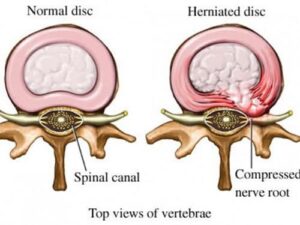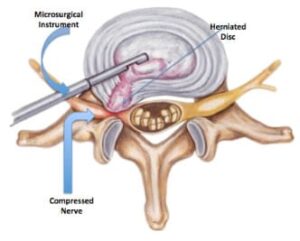Spine surgeries are almost never the first option for a person with lower back pain or radicular pain (i.e. sciatica), but when conservative treatment with PT, injections, and other treatments have failed, it may be time to discuss surgical options with your doctor. A common lumbar surgery which is less invasive than a fusion or laminectomy is called a microdiscectomy.
Patients who are candidates for a microdiscectomy include those who have failed conservative treatment, individuals with bowel and bladder changes in addition to their pain, those with progressive or significant neurological deficits (weakness/numbness), and those with unbearable pain. Ultimately the decision to have surgery is up to the patient and doctor as there are always risks associated. You should always discuss the procedure in depth with your surgeon in order to determine the risks and benefits!
The overall goal of a lumbar microdiscectomy is to remove the part of the disc pressing on the affected nerve while limiting damage to the surrounding structures. Unlike a fusion there is no hardware inserted and unlike a laminectomy the vertebrae itself is typically not operated on. There are fewer post-operative issues with a discectomy than other lumbar surgeries and patients typically have a much earlier discharge from the hospital. Outcomes with microdiscectomies have also been much improved as compared to fusions and laminectomies with patients reporting 90-95% positive results.
Individuals who have a microdiscectomy are encouraged to walk as tolerated immediately following their surgery but are advised to limit lifting tasks or heavy activity for 1-2 weeks. Physical therapy typically begins at 3-4 weeks post-op and many athletes will be able to return to their normal activities as able as 8 weeks post-op. Each individual is different and no two cases are the same, however and the recovery time may vary greatly between individuals. The focus of physical therapy will be on core, back, and hip strengthening in addition to improving flexibility. Education and activity modification will also likely be a large part of your PT in order to minimize the risk of reherniation.
If you have questions about back pain and are considering Physical Therapy, please consider us at Iron Health to help guide your treatment!


Disclaimer: If you continue to experience unbearable, reoccurring pain, be sure to schedule an appointment with your physician or join our physical therapy family and allow us to help you regain function.
Iron Health is located in Briarcliff Manor and the greater Westchester NY area; our neighboring towns include Chappaqua, Mount Kisco, Tarrytown, Irvington and Pleasantville. If you have any questions, fill out a Discovery Session form and we will contact you as soon as possible. OR If you have any questions, fill out a short form by clicking the button below and we will contact you as soon as possible.
